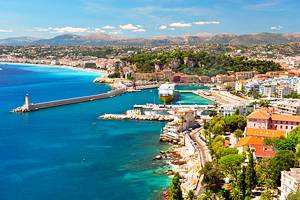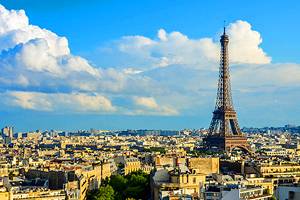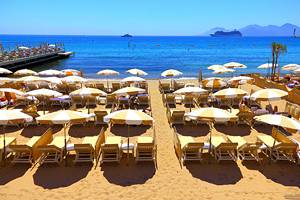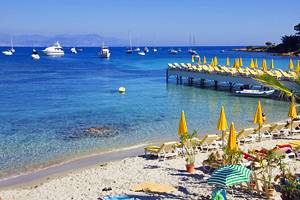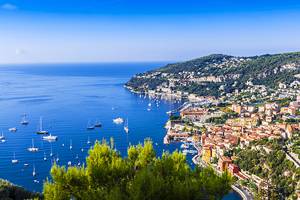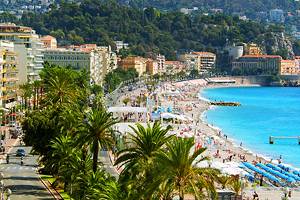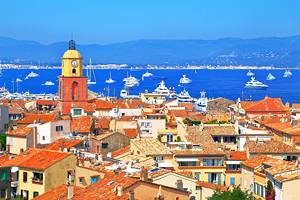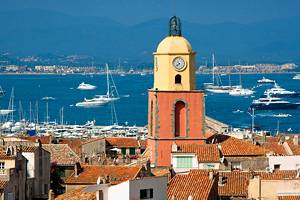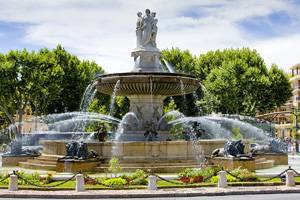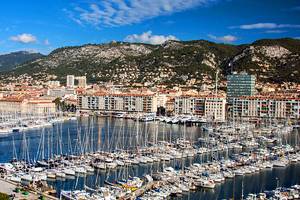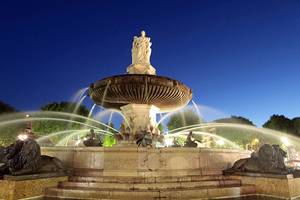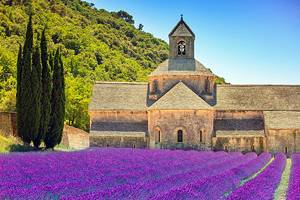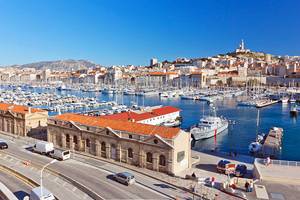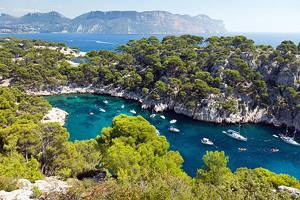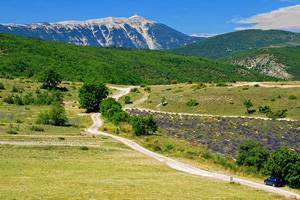Day Trips from Cannes
If you've based your vacation in Cannes, great choice! You will have the chance to discover many highlights of the French Riviera on day trips after exploring the tourist attractions in Cannes itself.
The location couldn't be better, right in the middle of the Côte d'Azur. Cannes nestles in a dreamy seaside spot, overlooking the Golfe de la Napoule bay. The surrounding coastline is dotted with quaint hilltop towns, alluring seaside villages, and other glamorous beach resorts.
Most of the French Riviera beach-holiday destinations also have amazing cultural attractions. Nice is known for its modern art collections; Saint-Tropez grew up from an old fishing village; and the historic center of Antibes features medieval charm and a fabulous Picasso museum.
Beyond the touristy spots are alluring off-the-beaten-path sights. The lesser-known beach resorts of Fréjus, Saint-Raphaël, Théoule-sur-Mer, and Mandelieu-La-Napoule offer a slow-paced and relaxing vacation experience. Only 18 kilometers from Cannes, the town of Grasse has a mild climate year-round and is famous for its perfumes.
Other wonderful places to visit are the little village of Vallauris, with its Picasso Museum inside the former chapel of a 12th-century monastic abbey, and Biot, a charming hilltop town.
For more sightseeing ideas, read our list of the top day trips from Cannes.
Monaco

This royal principality may be small in size (only two square kilometers), but its scenic splendor is truly grand. Stunning coastal views and a sublime Mediterranean environment distinguish Monaco. Palm trees and tropical flowers give the place an air of paradise.
Monaco enjoys an amazing setting on a rocky promontory known as "Le Rocher" ("The Rock"). Squeezed between The Rock's cliff sides is Monaco-Ville, the pedestrian Old Town of Monaco and the Palais Princier de Monaco, residence of H.S.H. Prince Albert II. One of Monaco's top tourist attractions, the Prince's Palace is open to the public for visits part of the year.
At the Monaco harbor, the scene of luxury yachts lives up to the town's reputation for extravagant wealth. The rich and famous are also drawn to Monaco's designer boutiques, upscale restaurants, and five-star hotels.
Despite the aura of exclusivity, Monaco will appeal to anyone who has an appreciation of beauty and culture. For entertainment, the Opéra de Monte-Carlo offers a superb schedule of classic operas, concerts, and ballet performances.
The Musée Oceanographique boasts a spectacular seaside location, outstanding aquariums, and interactive exhibits on marine science. Monaco's natural splendor is also found in the abundance of gorgeous gardens with mesmerizing views.
Read More: Places to Visit in the South of France
Saint-Tropez

Before Saint-Tropez became a legendary beach resort, it was just a little fishing village with the slow pace of a small town in Provence. Impressionist painters discovered the alluring quality of Saint-Tropez in the 19th century. But it was Brigitte Bardot's appearance in Et Dieu Créa la Femme (filmed in Saint-Tropez) in 1955 that really put the village on the tourist map.
Today designer boutiques, fancy restaurants, and private beach clubs are de rigueur, as would be expected of an internationally renowned resort town. However, Saint-Tropez has several excellent public beaches, and the historic village has retained its old-world character, seen in the quaint cobblestone streets and squares shaded by leafy plane trees.
Humble fishing boats mingle with luxury yachts in the Old Port (Vieux Port), while the quays feature outdoor cafés and colorful street art. Locals and tourists alike shop at the traditional Provençal market, held daily at the Place aux Herbes near the harbor.
Museums rank high on the list of cultural attractions in Saint-Tropez. The Musée de l'Annonciade displays an extensive collection of Impressionist and modern art. A 17th-century citadel houses the Museum of Maritime History.
Saint-Tropez is an 85-kilometer drive from Cannes, but the most enjoyable way to arrive here from Cannes is by boat. The ferry to Saint-Tropez from Cannes is a round-trip ferry boat service (about a 75-minute journey each way) that allows you to explore Saint-Tropez on your own for a full day.
Read More: Beach Destinations in France
Nice

For a day of sightseeing, Nice has it all: beaches, art museums, and an atmospheric Old Town. You can wander through a maze of pedestrian cobblestone streets, stroll the emblematic waterfront Promenade des Anglais, and visit the Musée des Beaux-Arts, all in one afternoon.
There are breathtaking vantage points from the hilltop Parc de la Colline du Château and the Monastère Notre-Dame-de-Cimiez in the Cimiez neighborhood. Both spots afford dazzling views of the Old Town, the Bay of Angels, and the coastline around Nice.
Nice also features lovely public squares and an array of pleasant gardens such as the Jardin Albert 1er near the Promenade des Anglais and the manicured grounds around the Musée Matisse.
Another highlight of the city: Great restaurants are found not far from the many tourist attractions. For instance, the five-star Le Negresco hotel on the Promenade des Anglais has a Michelin-starred restaurant, Le Chantecler, and a chic brasserie, La Rotonde.
Near the Place Masséna is the Michelin-starred Aromate Restaurant (2 Rue Gustave Deloye) and Les Deux Canailles, offering French haute cuisine with a Japanese twist (6 Rue Chauvain).
In the Old Town near the cathedral, try the Comptoir du Marché (8 Rue du Marché), a cozy and convivial bistro. Before or after visiting the Musée d'Art Moderne et d'Art Contemporain, stop for a meal at YOSE (20 Rue Bonaparte) for Peruvian and South American cuisine.
Eze

This picture-perfect medieval "perched" village boasts exceptional views, thanks to its dramatic location on a hilltop more than 400 meters above the Mediterranean Sea. On a clear day, the town's vantage point offers a sweeping view of the French Riviera coastline from Nice to Monaco.
Within the once-fortified village are winding cobblestone streets, quaint alleyways, bougainvillea-trimmed courtyards, inviting boutiques, and small galleries that display paintings by local artists.
You must not miss the Jardin Exotique, a lush garden with astounding vistas, and the Fragonard Perfume Museum. Other top attractions include the Michelin two-starred restaurant at La Chèvre d'Or hotel and the spectacularly scenic Nietzsche Path, a hiking trail that traverses a steep hillside down to the beach.
Since Eze is most easily accessible by car, many travelers will have the best experience by taking an organized tour.
Estérel Mountains

The dramatic Estérel Mountains rise immediately behind the Côte d'Azur coastline between Saint-Raphaël and Cannes, bordered by two valleys. Formed of ancient volcanic rock, the Estérel Mountains are characterized by the distinctive reddish and earthy hues of the landscape. Spectacular gorges and steep cliffs plunge directly into the sea.
The rugged hillsides and jagged peaks are overgrown with typical Mediterranean shrubbery and shaded by acacia, eucalyptus, and palm trees.
The highest peak of the Estérel Mountains is Mont Vinaigre, which reaches 618 meters. From Fréjus to Mont Vinaigre, the drive on the N7 includes 11 kilometers of a narrow forest road. At the summit of Mont Vinaigre, a breathtaking panoramic view awaits.
The Corniche de l'Estérel is another picturesque road (N98) that winds its way along the rocky coast between Saint-Raphaël and Cannes. The drive goes through the resort of Boulouris and passes by the impressive Cap du Dramont lighthouse.
An excellent place to stop is at the coastal village of Agay at the foot of the Rocheuse du Rastel (hillside) in a protected bay. This sunny village has wonderful beaches, and its calm seas are ideal for water sports such as sailing, kayaking, and jet skiing. A traditional Provençal market is held weekly at Place Giannetti, the town square near the waterfront.
Another gorgeous sight in the Estérel Mountains is the Pic de l'Ours, which can be approached from the village of Agay. The mostly single-lane road leads inland (for about 30 minutes) and encircles the Pic de l'Ours mountain peak, which reaches 496 meters. At the summit, near the Col Notre-Dame, there is a magnificent sweeping view of the rocky coastline.
Îles de Lérins

A short ferry ride from Cannes, the Îles de Lérins are found between the Golfe de la Napoule and the Golfe Juan. This group of islands was a center of ecclesiastical teachings and monastic life in the 5th and 6th centuries. In 660, the monastery assumed the Rule of Saint Benedict. Later, the islands were attacked by the Saracens and then by pirates from Genoa.
The Île Sainte-Marguerite is the largest island of the Lérins and is covered with lush eucalyptus trees and pine woods. The island has trails, which indicate historical sites, as well as botanical features. The 17th-century Fort Royal now houses the Musée de la Mer (Maritime Museum). An observatory overlooking the Etang du Batéguier (lagoon) is a great place for bird-watching.
Appreciated for its serene natural environment, the Île Saint-Honorat is home to a Cistercian monastery, the Abbaye de Lérins, which dates back to the Middle Ages.
Today a community of 21 monks participate in a life of prayer and work at the Abbaye de Lérins. You may visit the abbey's historic monuments and chapels. It is also possible to attend Mass or spend time in private prayer at the abbey church.
The ferry ride from Cannes to the Île Sainte-Marguerite or the Île Saint-Honorat takes just 15 minutes. Ferries to both islands depart and return several times a day throughout the year.
Read More: Tourist Attractions in Antibes-Juan-les-Pins
Antibes Juan-les-Pins

Antibes offers the best of both worlds: a quaint historic center full of cultural attractions, along with miles and miles of sandy beaches. This explains why this resort town draws so many visitors year-round, especially during summertime for beach vacations.
With its sea views and tangle of cobblestone streets, the Old Town is a pleasant place to wander. Along the way, you will discover pleasant public squares, browse boutiques, and stop at inviting cafés. Not to be missed in the Old Town is the Picasso Museum, which displays a renowned collection of Picasso's art in the medieval Château Grimaldi, a landmark in itself.
Antibes also encompasses the coastline of Cap d'Antibes and Juan les Pins, two areas that have several public beaches with beautiful sandy shores surrounded by shady pine trees.
To take in the scenery, try hiking the 3.7-kilometer seafront walk along the Chemin des Douaniers. The trail begins at the Plage de la Garoupe and winds up at the Villa Eilenroc, an elegant Belle Epoque mansion with a splendid rose garden. The villa and garden are open on Wednesdays and Saturdays from 10am until 4pm.
Those who appreciate history can visit the Archaeology Museum in the Bastion Saint-André to take in the captivating history and see fascinating ancient artifacts.
Music lovers will want to attend the legendary Jazz à Juan festival held annually in late June and July at an outdoor amphitheater by the sea. This jazz festival showcases exceptional talent including world-famous musicians.
Fréjus

This attractive port town was built on the site of a Roman city that Julius Caesar founded in 49 BCE. In fact, the remarkable Cathedral of Fréjus has a pre-Romanesque 5th-century baptistery that incorporates ancient Roman columns and is one of the earliest Christian churches in France.
At the Archaeology Museum, you can learn about the history of Fréjus during the antiquity period. The collection includes pieces found at archaeological digs in Fréjus, such as statues, mosaics, and objects used in everyday life. The museum also presents a large-scale model depicting the ancient Roman city that once thrived here.
The town's most noteworthy archaeological sites include the 1st- to 2nd-century Arènes (Roman Amphitheater) on the rue Henri Vadon, which originally accommodated around 10,000 spectators, and the 1st-century Théâtre Romain (Roman Theater) now an outdoor venue for Les Nuits Auréliennes, a summertime festival of French-language theater.
Fréjus offers a balmy climate, a bustling marina, and sandy beaches. It's a good choice for a day-trip destination if you are seeking the pleasure of sunshine and the seaside.
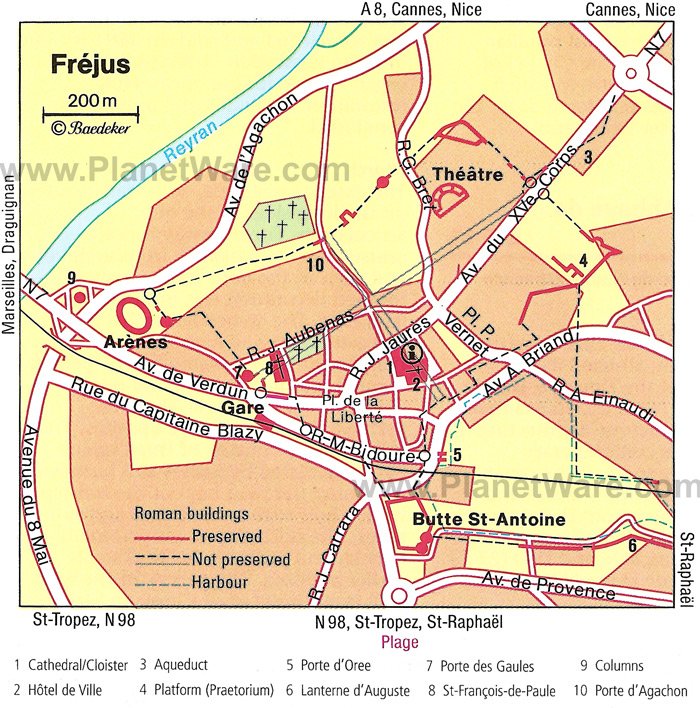
Saint-Raphaël

This sunny seaside resort extends over 36 kilometers of pristine coastline at the foot of the Estérel Mountains. You can choose from dozens of beaches, some sandy, others pebbly, or small quiet coves.
If you love water sports, especially sailing, this is the place to go! The Port de Santa-Lucia in Saint-Raphaël is considered one of the best marinas on the Côte d'Azur. The Port de Santa-Lucia also has many waterfront restaurants along the quays that serve gourmet cuisine.
During the Victorian era, Saint-Raphaël was an upscale holiday destination with grand Belle Epoque hotels and villas. Unfortunately, much of the town's stately architecture was destroyed in the blitz of the Second World War. However, there's still a charming old fishing port, appealing waterfront neighborhoods, and a vibrant commercial center.
You will find plenty of things to do here. Start by wandering the narrow streets of the Vieille Ville (Old Town) and shopping at the Provençal markets (Place Victor Hugo, Place de la République, and Place Giannetti). Continue your tour by strolling along the Santa-Lucia Marina or the Vieux Port, the old fishing harbor.
Other must-see attractions include the Neo-Byzantine Basilique Notre-Dame de la Victoire and, housed in a 12th-century Romanesque church, the Museum of History, Prehistory and Underwater Archaeology that displays treasures of the Roman Empire uncovered from shipwrecks. The museum also features splendid panoramic sea views from the building's tower.
Grasse

Grasse is a quintessential Provençal hilltop town with superb views of the Provence countryside. Aromatic orange blossoms, roses, jasmine, lavender, and violets bloom in profusion around Grasse.
The local flowers provide the essential oils to make exquisite fragrances. In fact, Grasse is world-renowned for its perfumes, introduced in the 16th century by Catherine de Medici.
The International Perfume Museum (2 Boulevard du Jeu de Ballon) educates you about the history of perfumes, soaps, and cosmetics. In addition, many perfume factories in Grasse, such as Fragonard, Molinard, and Galimard, offer guided tours, perfume workshops, and boutiques.
France's Ministry of Culture has labeled Grasse a Ville d'Art et d'Histoire (City of Art and History) because of its unique cultural heritage. The charming historic center of Grasse can only be explored on foot because of the narrow thoroughfares.
At the heart of the Old Town, the 13th-century Cathédrale Notre-Dame-du-Puy de Grasse has a simple facade inspired by the architecture of the Liguria region (near Genoa in Italy) and is filled with exceptional works of religious art, including pieces by the School of Louis Brea and Pierre-Paul Rubens.
Another must-see attraction is the Musée Jean-Honoré Fragonard, dedicated to the Rococo painter Jean-Honoré Fragonard. The collection includes 20 major works by Fragonard as well as paintings by two other renowned artists from Grasse.
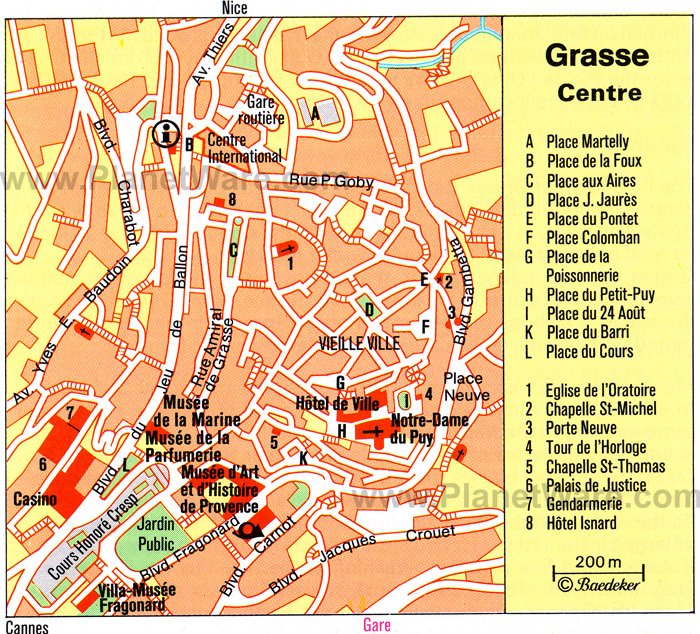
Vallauris

Above the Golfe-Juan, about five kilometers from Cannes, and surrounded by fragrant orange groves, this little town once belonged to the monks of the Lérins Islands. The rich religious heritage is seen in the town's many historic chapels and churches.
The 12th-century Romanesque chapel of the Château de Vallauris (formerly the priory of the Abbey of Lérins) now houses the Musée National Picasso, La Guerre et la Paix. In 1952, Pablo Picasso painted the vaulting of the chapel with his famous War and Peace, two immense works of art covering more than 100 square meters.
Another main attraction in Vallauris is the traditional decorative pottery. Vallauris' history of pottery-making dates back to the Gallo-Roman and early Christian era. Today, many talented potters work in Vallauris.
Artists' ateliers are often open for visits, arranged through the Tourist Office, and the Vallauris Institute of Arts offers week-long workshops focused on the art of creating contemporary ceramics.
The Renaissance-era wings of the Château de Vallauris (the same building where the Picasso Museum is located) house the Musée Magnelli - Musée de la Céramique (Ceramics Museum). The museum displays everything from ancient pottery to contemporary artisanal ceramics, along with a collection of paintings by Alberto Magnelli (an Italian modern artist).
Théoule-sur-Mer

One of the most beautiful Côte d Azur resorts, Théoule-sur-Mer is tucked into a small sheltered bay between the Estérel Mountains and the Mediterranean Sea. This former fishing village is now a popular holiday destination less than 15 kilometers from Cannes.
There are several public beaches in Théoule-sur-Mer, all located within L'Estérel National Park; many are fine sandy beaches and some of the beaches have pebble shorelines and more rugged terrain. Théoule-sur-Mer also has private beaches with stylish waterfront restaurants.
Théoule-sur-Mer offers many leisure activities including hiking, tennis, golfing, horseback riding, sailing, and snorkeling. Perfect for a summer vacation, Théoule-sur-Mer immerses you in the slow-paced ambience of Provence by the sea.
Read More: Beaches in the South of France
Mandelieu-La-Napoule

The seaside community of Mandelieu-La Napoule enjoys an idyllic setting, at the foot of the Massif du Tanneron (five kilometers west of Cannes) with the verdant Estérel Mountains as a backdrop.
The town includes the quaint, old fishing village of La Napoule and the more modern beach resort of Mandelieu. Less crowded than Cannes, this area still exudes the vacation spirit of the French Riviera.
Sun worshippers flock to the seven pristine sandy beaches found along the three-kilometer coastline of Mandelieu-La Napoule. Water quality is posted daily to ensure the safety of bathers and swimmers.
Other things to do include nature walks by the seaside, hiking in the forest or by the coast, and golfing at one of the two 18-hole golf courses.
For gourmet dining, you should head to the port of La Napoule. The picturesque waterfront is lined with upscale restaurants and casual bistros.
During the tourist season, ferries travel regularly from Mandelieu-La Napoule to Cannes, Monaco, Saint-Tropez, and the Île Sainte-Marguerite.
Biot

This quaint medieval hilltop village will enchant you with its narrow cobblestone streets, quiet alleyways, and pleasant little squares. Built on the slopes of a steep hill, this typical village perché (perched village) features many pedestrian staircases that lead up to viewpoints and reward with lovely panoramas.
Biot has an interesting history and played an important role in the Crusades during the 12th century. The Eglise Sainte-Marie-Madeleine was built on the ruins of a 12th-century Romanesque church and was largely rebuilt in the 15th century. Inside, there is a beautiful altarpiece, the Madonna with Rosary by Louis Bréa in the 16th century.
The village is well known for its arts and crafts, including ceramics, glass blowing, weaving, and silk-screen printing. Another highlight of Biot, the Musée National Fernand Léger on the Chemin du Val de Pôme, displays a comprehensive collection of Léger's works.
Mougins

Surrounded by ancient ramparts, Mougins (about 10 kilometers from Cannes) overlooks the rolling hills of the Valmasque Forest, with panoramas that stretch all the way to Grasse, the Bay of Cannes, and the Lérins Islands.
This medieval perched village is unique because of its cultural heritage. The artists Jean Cocteau, Joseph Fernand Henri Léger, and Pablo Picasso were drawn to the village's beauty and enchanting ambience. This artistic spirit lives on in a plethora of art galleries and studios.
A must-see stop for art lovers is the Musée d'Art Classique de Mougins, which displays Classical-era Greek and Roman antiquities, as well as treasures from ancient Egyptian tombs. The museum also presents modern art inspired by antiquities, including the works of famous artists such as Marc Chagall, Pablo Picasso, Henri Matisse, Salvador Dalí, Jean Cocteau, and Alexander Calder.
Gourmands will appreciate that Mougins has dozens of excellent restaurants. The town has been associated with exceptional gastronomy since 1912, when local chef Célestin Véran won the Équipages de la Flotte, a prestigious cooking contest.


